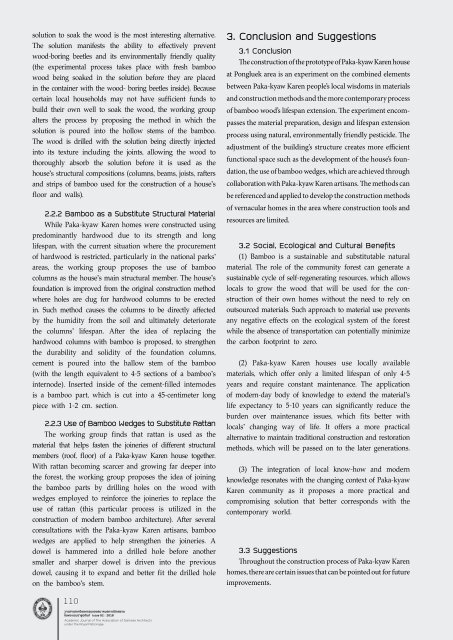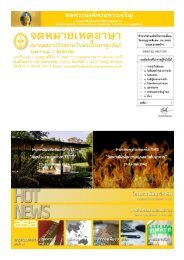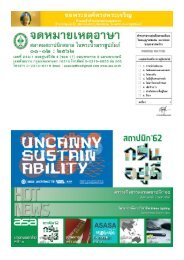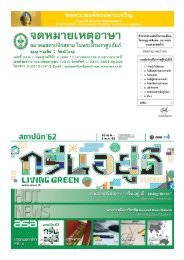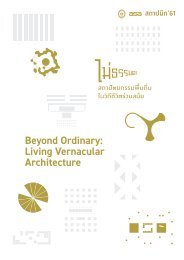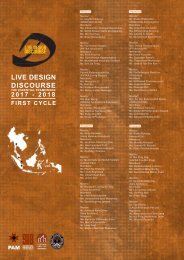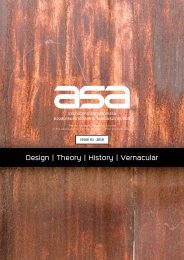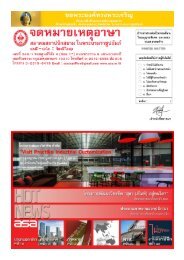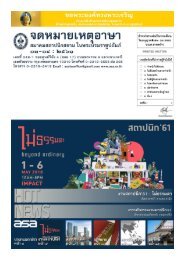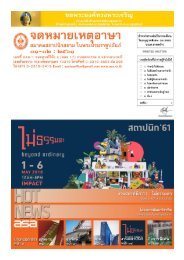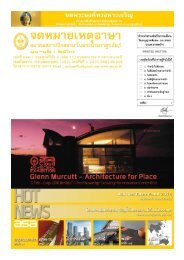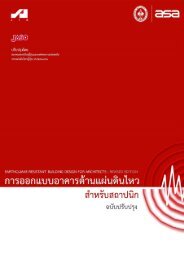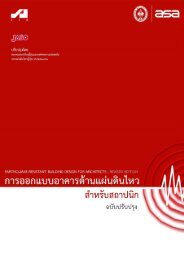ASA JOURNAL Vol.2 | 2018
Create successful ePaper yourself
Turn your PDF publications into a flip-book with our unique Google optimized e-Paper software.
solution to soak the wood is the most interesting alternative.<br />
The solution manifests the ability to effectively prevent<br />
wood-boring beetles and its environmentally friendly quality<br />
(the experimental process takes place with fresh bamboo<br />
wood being soaked in the solution before they are placed<br />
in the container with the wood- boring beetles inside). Because<br />
certain local households may not have sufficient funds to<br />
build their own well to soak the wood, the working group<br />
alters the process by proposing the method in which the<br />
solution is poured into the hollow stems of the bamboo.<br />
The wood is drilled with the solution being directly injected<br />
into its texture including the joints, allowing the wood to<br />
thoroughly absorb the solution before it is used as the<br />
house’s structural compositions (columns, beams, joists, rafters<br />
and strips of bamboo used for the construction of a house’s<br />
floor and walls).<br />
2.2.2 Bamboo as a Substitute Structural Material<br />
While Paka-kyaw Karen homes were constructed using<br />
predominantly hardwood due to its strength and long<br />
lifespan, with the current situation where the procurement<br />
of hardwood is restricted, particularly in the national parks’<br />
areas, the working group proposes the use of bamboo<br />
columns as the house’s main structural member. The house’s<br />
foundation is improved from the original construction method<br />
where holes are dug for hardwood columns to be erected<br />
in. Such method causes the columns to be directly affected<br />
by the humidity from the soil and ultimately deteriorate<br />
the columns’ lifespan. After the idea of replacing the<br />
hardwood columns with bamboo is proposed, to strengthen<br />
the durability and solidity of the foundation columns,<br />
cement is poured into the hallow stem of the bamboo<br />
(with the length equivalent to 4-5 sections of a bamboo’s<br />
internode). Inserted inside of the cement-filled internodes<br />
is a bamboo part, which is cut into a 45-centimeter long<br />
piece with 1-2 cm. section.<br />
2.2.3 Use of Bamboo Wedges to Substitute Rattan<br />
The working group finds that rattan is used as the<br />
material that helps fasten the joineries of different structural<br />
members (roof, floor) of a Paka-kyaw Karen house together.<br />
With rattan becoming scarcer and growing far deeper into<br />
the forest, the working group proposes the idea of joining<br />
the bamboo parts by drilling holes on the wood with<br />
wedges employed to reinforce the joineries to replace the<br />
use of rattan (this particular process is utilized in the<br />
construction of modern bamboo architecture). After several<br />
consultations with the Paka-kyaw Karen artisans, bamboo<br />
wedges are applied to help strengthen the joineries. A<br />
dowel is hammered into a drilled hole before another<br />
smaller and sharper dowel is driven into the previous<br />
dowel, causing it to expand and better fit the drilled hole<br />
on the bamboo’s stem.<br />
3. Conclusion and Suggestions<br />
3.1 Conclusion<br />
The construction of the prototype of Paka-kyaw Karen house<br />
at Pongluek area is an experiment on the combined elements<br />
between Paka-kyaw Karen people’s local wisdoms in materials<br />
and construction methods and the more contemporary process<br />
of bamboo wood’s lifespan extension. The experiment encompasses<br />
the material preparation, design and lifespan extension<br />
process using natural, environmentally friendly pesticide. The<br />
adjustment of the building’s structure creates more efficient<br />
functional space such as the development of the house’s foundation,<br />
the use of bamboo wedges, which are achieved through<br />
collaboration with Paka-kyaw Karen artisans. The methods can<br />
be referenced and applied to develop the construction methods<br />
of vernacular homes in the area where construction tools and<br />
resources are limited.<br />
3.2 Social, Ecological and Cultural Benefits<br />
(1) Bamboo is a sustainable and substitutable natural<br />
material. The role of the community forest can generate a<br />
sustainable cycle of self-regenerating resources, which allows<br />
locals to grow the wood that will be used for the construction<br />
of their own homes without the need to rely on<br />
outsourced materials. Such approach to material use prevents<br />
any negative effects on the ecological system of the forest<br />
while the absence of transportation can potentially minimize<br />
the carbon footprint to zero.<br />
(2) Paka-kyaw Karen houses use locally available<br />
materials, which offer only a limited lifespan of only 4-5<br />
years and require constant maintenance. The application<br />
of modern-day body of knowledge to extend the material’s<br />
life expectancy to 5-10 years can significantly reduce the<br />
burden over maintenance issues, which fits better with<br />
locals’ changing way of life. It offers a more practical<br />
alternative to maintain traditional construction and restoration<br />
methods, which will be passed on to the later generations.<br />
(3) The integration of local know-how and modern<br />
knowledge resonates with the changing context of Paka-kyaw<br />
Karen community as it proposes a more practical and<br />
compromising solution that better corresponds with the<br />
contemporary world.<br />
3.3 Suggestions<br />
Throughout the construction process of Paka-kyaw Karen<br />
homes, there are certain issues that can be pointed out for future<br />
improvements.<br />
(1) A collaboration between Paka-kyaw Karen people and<br />
local authorities such as the National Park should be carried out<br />
to find a practical solution for bamboo reforestation program<br />
to take place in a suitable and properly operated land. The<br />
development of a natural material bank should be done to<br />
handle other natural materials after they have gone through the<br />
lifespan extension process.<br />
(2) No substantial study and solution has been provided on<br />
the lifespan extension of the traditional roofing material<br />
(Ta Kror leaves) of Paka-kyaw Karen homes. There has not been<br />
any experiment done on a substitute material that can withstand<br />
the sun and rain, which can be a more challenging and timeconsuming<br />
process.<br />
Bibliography<br />
Acknowledgements<br />
The study and construction of the prototype of Paka-kyaw<br />
Karen house cannot be achieved without the help and<br />
invaluable knowledge of the Paka-kyaw Karen artisans, and<br />
support from the Pidthong Lungpra Foundation, Local<br />
Formation Foundation Community Organizations Development<br />
Institute, Kaengkrachan National Park, and Chulalongkorn<br />
University, which have been significant resources of information<br />
throughout the entire process of the project, including the<br />
dedication and contribution from the students from the 2014<br />
and 2015 Basin Architecture Morphology and Environmental<br />
and Architectural Conservation class.<br />
Anupanphong, Akaraphong. (2007). Paka-kyaw Karen homes: Sustainability and Adjustment under Eco-Culture culture of<br />
Cyclic agriculture. Masters Thesis of Master of Arts Program). Silpakorn University.<br />
Olarnratmanee, Raweewan. (2017). Dynamics of Vernacular Architecture of Ethic Groups: A Case Study of Tai Yai Ethic Group<br />
in Khun Yuam, Mae Hongson Province and Karen Community in Mae Lha Temporary Shelter in Tak Province.<br />
Built Environment Inquiry Journal. Faculty of Architecture. Khon Kaen University.<br />
Pancharueng, Ularn and Olarnratmanee, Raweewan. (2015. Patterns and Formations of Paka-kyaw Karen Architecture in<br />
Mae Lha Temporary Shelter in Tak Province. Environmental Design Academic Journal.<br />
Wichaidit, Soraphong. (2004). Formation of Identity of Karen Migrants: A Case Study of Mae Lha Temporary Shelter in<br />
Tak Province. Masters Thesis of Master of Arts Program in Anthropology. Chulalongkorn University.<br />
110 111<br />
วารสารสถาปัตยกรรมของสมาคมสถาปนิกสยาม<br />
ในพระบรมราชูปถัมภ์ Issue 02 / <strong>2018</strong><br />
Academic Journal of The Association of Siamese Architects<br />
under the Royal Patronage<br />
วารสารสถาปัตยกรรมของสมาคมสถาปนิกสยาม<br />
ในพระบรมราชูปถัมภ์ Issue 02 / <strong>2018</strong><br />
Academic Journal of The Association of Siamese Architects<br />
under the Royal Patronage


